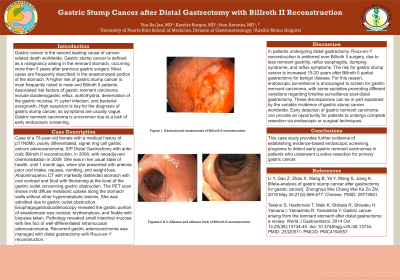Monday Poster Session
Category: Stomach
P2817 - Gastric Stump Cancer After Distal Gastrectomy With Billroth II Reconstruction
Monday, October 23, 2023
10:30 AM - 4:15 PM PT
Location: Exhibit Hall

Has Audio

Yue-Sai Jao, MD
University of Puerto Rico School of Medicine
San Juan, PR
Presenting Author(s)
Yue-Sai Jao-Ayala, MD1, Karelys Burgos-Irizarry, MD1, Ivan Antunez, MD2
1University of Puerto Rico Medical Sciences Campus, San Juan, Puerto Rico; 2University of Puerto Rico School of Medicine, San Juan, Puerto Rico
Introduction: Gastric cancer is the second leading cause of cancer-related death worldwide. Gastric stump cancer is defined as a malignancy arising in the remnant stomach, occurring more than 5 years after previous gastric surgery. Most cases are frequently described in the anastomosed portion of the stomach. A higher risk of gastric stump cancer is most frequently noted in male and Billroth II patients. Associated risk factors of gastric remnant carcinoma include intragastric reflux, achlorhydria, and bacterial overgrowth. High suspicion is key for the diagnosis of gastric stump cancer, as symptoms are usually vague. Gastric remnant carcinoma is uncommon due to a lack of early endoscopic screening.
Case Description/Methods: Case of a 75-year-old female with a medical history of pT1N0M0, poorly differentiated, signet ring cell gastric antrum adenocarcinoma, S/P Distal Gastrectomy with ante-colic Biliroth II reconstruction, in 2008, with neoadjuvant chemoradiation in 2009. She was in her usual state of health, until 1 month ago, when she presented with anemia, poor oral intake, nausea, vomiting, and weight loss. She was admitted due to gastric outlet obstruction. Esophagogastroduodenoscopy revealed gastric portion of anastomosis was nodular, erythematous, and friable S/P biopsies. Pathology revealed small intestinal mucosa with few foci of well-differentiated intramucosal adenocarcinoma. Abdominopelvic CT with markedly distended stomach with oral contrast and food with thickening at the level of the gastric outlet concerning for gastric obstruction. PET scan shows mild diffuse metabolic uptake along the stomach walls without other hypermetabolic lesions. Recurrent gastric adenocarcinoma was managed with distal gastrectomy with Roux-en-Y reconstruction.
Discussion: In patients undergoing distal gastrectomy, Roux-en-Y reconstruction is preferred over Billroth II surgery, due to less remnant gastritis, reflux esophagitis, dumping syndrome and reflux symptoms. The risk for gastric stump cancer is increased 15-20 years after Billroth II partial gastrectomy for benign disease. For this reason, endoscopic surveillance is encouraged to screen for gastric remnant carcinoma, with some societies promoting different variations regarding timeline surveillance post-distal gastrectomy. This case study provides further evidence of establishing evidence-based endoscopic screening programs to detect early gastric remnant carcinomas in patients who underwent curative resection for primary gastric cancer.
Disclosures:
Yue-Sai Jao-Ayala, MD1, Karelys Burgos-Irizarry, MD1, Ivan Antunez, MD2. P2817 - Gastric Stump Cancer After Distal Gastrectomy With Billroth II Reconstruction, ACG 2023 Annual Scientific Meeting Abstracts. Vancouver, BC, Canada: American College of Gastroenterology.
1University of Puerto Rico Medical Sciences Campus, San Juan, Puerto Rico; 2University of Puerto Rico School of Medicine, San Juan, Puerto Rico
Introduction: Gastric cancer is the second leading cause of cancer-related death worldwide. Gastric stump cancer is defined as a malignancy arising in the remnant stomach, occurring more than 5 years after previous gastric surgery. Most cases are frequently described in the anastomosed portion of the stomach. A higher risk of gastric stump cancer is most frequently noted in male and Billroth II patients. Associated risk factors of gastric remnant carcinoma include intragastric reflux, achlorhydria, and bacterial overgrowth. High suspicion is key for the diagnosis of gastric stump cancer, as symptoms are usually vague. Gastric remnant carcinoma is uncommon due to a lack of early endoscopic screening.
Case Description/Methods: Case of a 75-year-old female with a medical history of pT1N0M0, poorly differentiated, signet ring cell gastric antrum adenocarcinoma, S/P Distal Gastrectomy with ante-colic Biliroth II reconstruction, in 2008, with neoadjuvant chemoradiation in 2009. She was in her usual state of health, until 1 month ago, when she presented with anemia, poor oral intake, nausea, vomiting, and weight loss. She was admitted due to gastric outlet obstruction. Esophagogastroduodenoscopy revealed gastric portion of anastomosis was nodular, erythematous, and friable S/P biopsies. Pathology revealed small intestinal mucosa with few foci of well-differentiated intramucosal adenocarcinoma. Abdominopelvic CT with markedly distended stomach with oral contrast and food with thickening at the level of the gastric outlet concerning for gastric obstruction. PET scan shows mild diffuse metabolic uptake along the stomach walls without other hypermetabolic lesions. Recurrent gastric adenocarcinoma was managed with distal gastrectomy with Roux-en-Y reconstruction.
Discussion: In patients undergoing distal gastrectomy, Roux-en-Y reconstruction is preferred over Billroth II surgery, due to less remnant gastritis, reflux esophagitis, dumping syndrome and reflux symptoms. The risk for gastric stump cancer is increased 15-20 years after Billroth II partial gastrectomy for benign disease. For this reason, endoscopic surveillance is encouraged to screen for gastric remnant carcinoma, with some societies promoting different variations regarding timeline surveillance post-distal gastrectomy. This case study provides further evidence of establishing evidence-based endoscopic screening programs to detect early gastric remnant carcinomas in patients who underwent curative resection for primary gastric cancer.
Disclosures:
Yue-Sai Jao-Ayala indicated no relevant financial relationships.
Karelys Burgos-Irizarry indicated no relevant financial relationships.
Ivan Antunez indicated no relevant financial relationships.
Yue-Sai Jao-Ayala, MD1, Karelys Burgos-Irizarry, MD1, Ivan Antunez, MD2. P2817 - Gastric Stump Cancer After Distal Gastrectomy With Billroth II Reconstruction, ACG 2023 Annual Scientific Meeting Abstracts. Vancouver, BC, Canada: American College of Gastroenterology.
